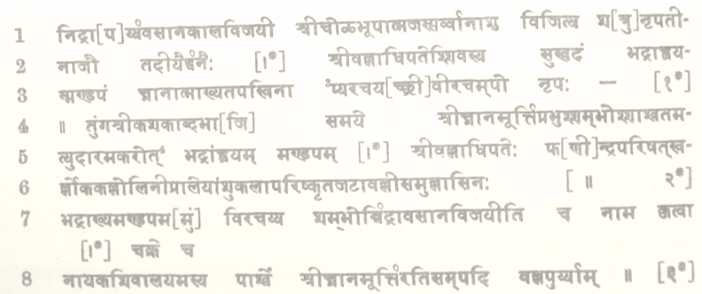|
The Indian Analyst
|
North Indian Inscriptions |
COCHIN PLATES OF BHASKARA RAVIVARMAN. No. 12.— THREE INSCRIPTIONS OF CHOLA CHIEFS. ......This inscription1 is engraved on the south wall of a maṇḍapa in front of the Bilvanâthêśvara shrine at Tiruvallam in the North Arcot district. It consists of three Sanskṛit verses in the Grantha alphabet and records the erection, by an ascetic named Jñânâtman (verse 1) or Jñânamûrti (verses 2 and 3), of the maṇḍapa on which it is engraved. The funds for the building were provided by a chief, called Vîra-Champa, who was the son of a Chôḷa king (verse 1) ; and the erection took place in Śaka-Saṁvat 1236 (verse 2). The building received the name “Bhadra-maṇḍapa,” i.e. the auspicious maṇḍapa (verses 1, 2 and 3), and the second name Nidrâvasânavijayi-maṇḍapa (verse 3), which was derived from a biruda of Vîra-Champa (verse 1). Jñânamûrti also built a shrine of Śiva, called Nâyaka-Śivâlaya, on the side of the maṇḍapa (verse 3). The name of this shrine may also refer to Vîra-Champa, and suggests that he was a Nâyaka or lieutenant of a unnamed king. Tiruvallam is referred to under the form Valla (verse 3), and its Śiva temple is called “the lord of Śrî-Valla” (verses 1 and 2).
TEXT.2
TRANSLATION. ......(Verse 1.)4 The glorious king Vîra-Champa, who used to win victories at the time of the
competition of sleep,5 (and) who was the son of the glorious Chôḷa king,― having
speedily conquered all the hostile kings in battle,― caused to be built with their treasures, by
an ascetic, called Jñânâtman, a maṇḍapa, named Bhadra (i.e. auspicious), which affords delight
to Śiva, the lord of Śrî-Valla. ......1 No. 3 of 1890 in Dr. Hultzsch’s Progress Report for October 1889 to January 1890.
| ||||||||||||||||||||||||||||||||||||||||||||||||||||||||||||||||||||||||||||
| > |
|
>
|








